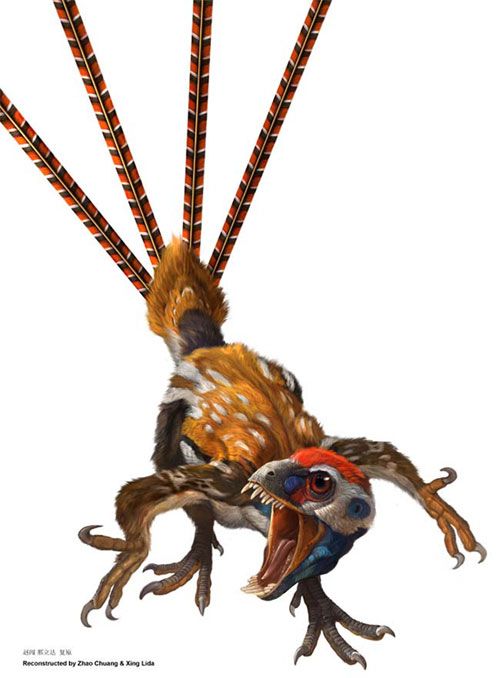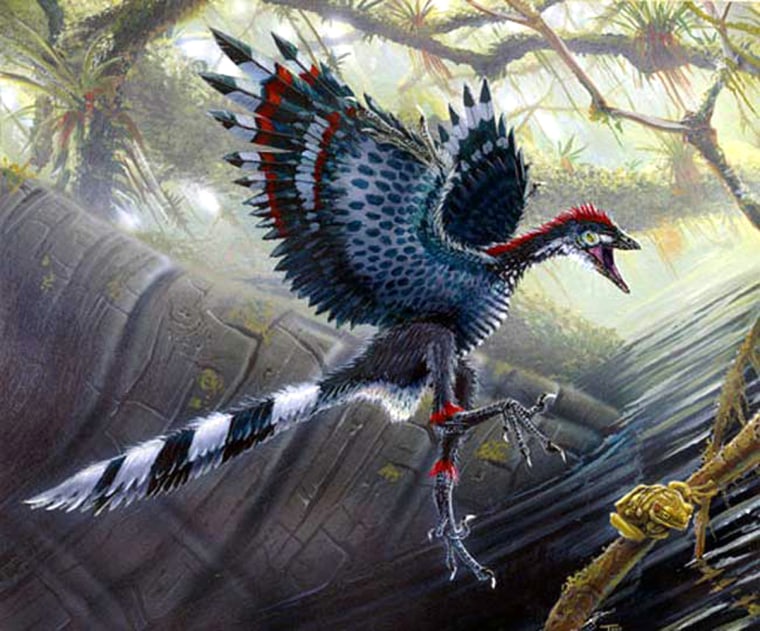According to a new review paper published in the journal Trends in Ecology & Evolution, feathers arose 250-230 million years ago, during the Early Triassic, when life was recovering from the devastating end-Permian mass extinction.
Reconstruction of Kulindadromeus zabaikalicus. Image credit: Andrey Atuchin.
It is shocking to realize that feathers originated long before birds because feathers have generally been regarded as the key innovation that drove the success of the avian fauna.
However, thousands of fossils from China have shown that many non-avian dinosaurs also had feathers, including feather types not found in birds today.
Those discoveries extended the origin of feathers minimally back to 175 million years ago — about 25 million years before the first generally acknowledged bird, Archaeopteryx.
Recent discoveries of feathers in ornithischian dinosaurs hinted that they are a character of dinosaurs as a whole.
Another startling discovery showed that even pterosaurs had four kinds of feather, apparently similar in form with those of dinosaurs, their closest relatives.
“The oldest bird is still Archaeopteryx first found in the Late Jurassic of southern Germany in 1861, although some species from China are a little older,” said University of Bristol’s Professor Mike Benton, lead author of the paper.
“Those fossils all show a diversity of feathers: down feathers over the body and long, vaned feathers on the wings. But, since 1994, paleontologists have been contending with the perturbing discovery, based on hundreds of amazing specimens from China, that many dinosaurs also had feathers.”
“At first, the dinosaurs with feathers were close to the origin of birds in the evolutionary tree,” added co-author Dr. Baoyu Jiang, a researcher at the University of Nanjing.
“This was not so hard to believe. So, the origin of feathers was pushed back at least to the origin of those bird-like dinosaurs, maybe 200 million years ago.”
Reconstruction of one of the studied Yanliao Biota pterosaurs, with four different feather types over its head, neck, body, and wings, and a generally ginger-brown color. Image credit: Yuan Zhang.
“Then, we had the good fortune to work on Kulindadromeus zabaikalicus, a feathered plant-eating dinosaur that lived in the lake-dotted lowlands of Jurassic Siberia between 169 and 144 million years ago,” said co-author Dr. Maria McNamara, from University College Cork.
“This dinosaur showed amazingly well-preserved skin covered with scales on the legs and tail, and strange whiskery feathers all over its body.”
“What surprised people was that this was a dinosaur that was as far from birds in the evolutionary tree as could be imagined. Perhaps feathers were present in the very first dinosaurs.”
“Modern birds like chickens often have scales on their legs or necks, and we showed these were reversals: what had once been feathers had reversed to be scales,” said co-author Dr. Danielle Dhouailly, from the University of Grenoble.
“In fact, we have shown that the same genome regulatory network drives the development of reptile scales, bird feathers, and mammal hairs. Feathers could have evolved very early.”
“The breakthrough came when we were studying two new pterosaurs from China. We saw that many of their whiskers were branched. We expected single strands — monofilaments — but what we saw were tufts and down feathers. Pterosaurs had feathers,” Dr. Jiang said.
“This drives the origin of feathers back to 250 million years ago at least,” Professor Benton said.
“The point of origin of pterosaurs, dinosaurs and their relatives. The Early Triassic world then was recovering from the most devastating mass extinction ever, and life on land had come back from near-total wipe-out.”
“Paleontologists had already noted that the new reptiles walked upright instead of sprawling, that their bone structure suggested fast growth and maybe even warm-bloodedness, and the mammal ancestors probably had hair by then.”
“So, the dinosaurs, pterosaurs and their ancestors had feathers too. Feathers then probably arose to aid this speeding up of physiology and ecology, purely for insulation. The other functions of feathers, for display and of course for flight, came much later.”
Source: sci.news












